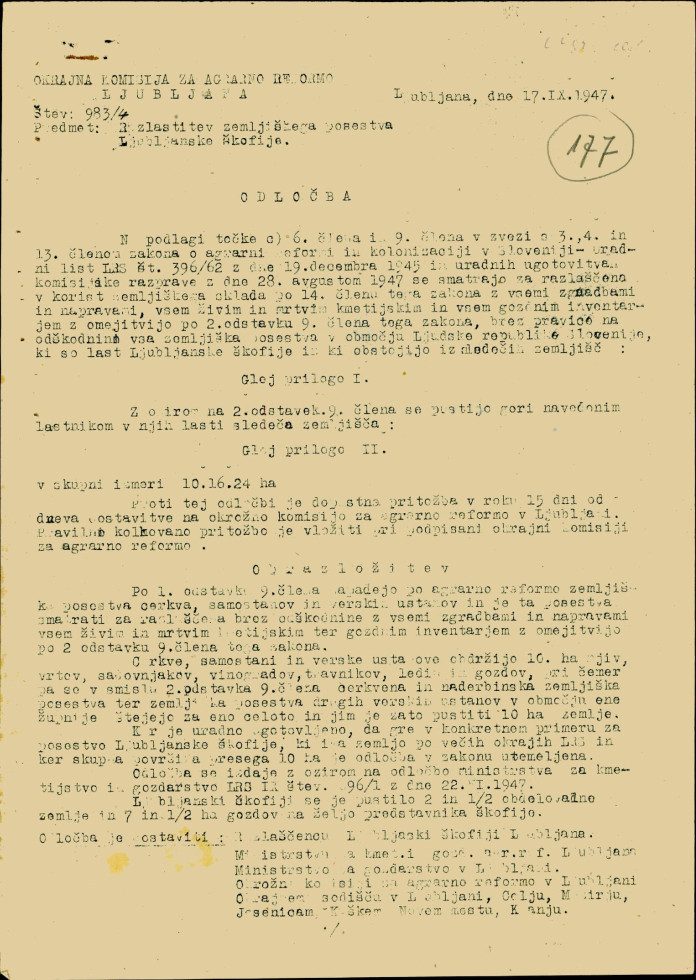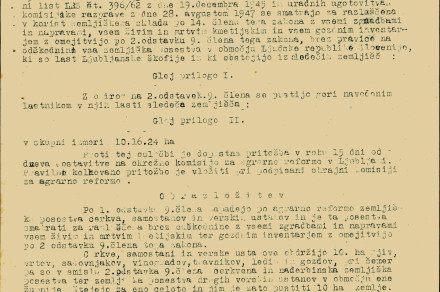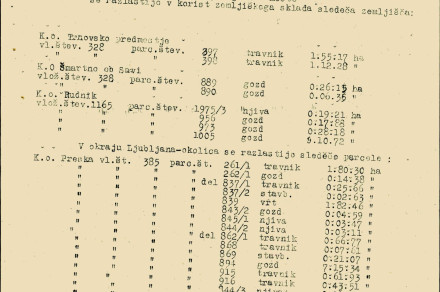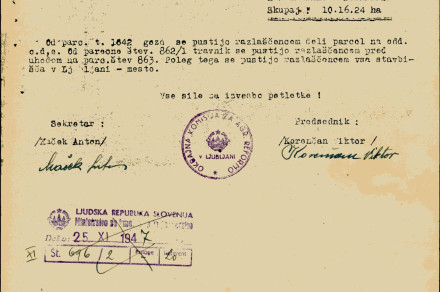The Expropriation of the Land Estates owned by the Diocese of Ljubljana
Ljubljana, September 17, 1947
Original, decision (2 pages), annex I (26 pages), annex II (1 page)
Reference code: SI AS 1118, Ministrstvo za kmetijstvo in gozdarstvo Ljudske republike Slovenije, šk. 2 (Agrarna Reforma, Ljubljana okolica)

Decision of the Ljubljana District Commission for Agrarian Reform on the expropriation of land of the Ljubljana Diocese, 1947. | Author Arhiv Republike Slovenije
The agrarian reform was a political-economic measure, legalized as a prerequisite for a continued development of economic policy in the field of agriculture, aimed at transforming it into a socialist model with an emphasis on collectivization. It was a conditio sine qua non of the post war agricultural policies in Yugoslavia, and thus also in Slovenia.
August 28, 1945, was a tragic day for many Slovenians. Namely, it was the day the so-called agrarian reform commenced. Initially perceived as a positive change intending to reduce social disparities between large and small farmers, the agrarian reform instead expropriated most farmers, pushing them to the brink of poverty. The reform was carried out mainly throughout 1946 and included expropriation without any compensations. It was legally “covered”, basing its strength on the slogan that the land was to be given to those who cultivate it, which meant that all large landowners were expropriated. Every step of the way was legally regulated and the newly acquired state property was immediately registered into the land register. In addition to land, the reform also covered buildings, machines (tractors) and cattle.
Agrarian reform also affected all the land owned by various religious institutions (dioceses, parishes, monasteries) and large estates (both forest and agricultural land) that exceeded the landholding maximum. This was 10 hectares of fields, gardens, orchards, vineyards, meadows, no longer cultivated fields, and forests. Religious institutions, churches, monasteries and church authorities of greater significance were allowed to retain 30 hectares of arable land and 30 hectares of forests.
Based on the Article 31 of the Agrarian Reform and Colonization Act, six district commissions were established in the People’s Republic of Slovenia, within which there were 37 regional commissions. Within the District Commission for the Agrarian Reform for the Ljubljana District there operated the Regional Commission for the Agrarian Reform for the Ljubljana Surroundings, while the District Commission for the City of Ljubljana included the operation of the Regional Commission for the City of Ljubljana. Based on its decision no. 983/4 of September 17, 1947, the Ljubljana Regional Commission completely expropriated the land estates of the Ljubljana Diocese in the regions of Ljubljana city, Ljubljana surroundings (which included also parcels situated in today’s Triglav National Park), Kranj, Celje, Mozirje, Krško, and Novo mesto. The land was expropriated and entered into the land registers at the district courts located in Ljubljana, Celje, Mozirje, Jesenice, Krško, Novo mesto, and Kranj. The Diocese of Ljubljana was allowed to retain some of the lands.
The Agrarian Reform and Colonization Act stated that when an owner owned land in several regions, the expropriation decision needed to be issued by the regional commission of the region where most of the expropriated land was located. Even though in this case the largest part of the land was in the region of Jesenice, the Ministry of Agriculture and Forestry decided that it would not be contrary to the spirit of the law if the decision for the expropriation of the land owned by the Diocese of Ljubljana was issued by the Regional Commission for the Agrarian Reform in Ljubljana. They justified this by saying that the owner’s headquarters and main administration were situated in Ljubljana, which served as the logical centre for all parts of this extensive land estate. Based on this, the decision issued by the Regional Commission for the Agrarian Reform in Mozirje no. 510/46 of July 10, 1946, was annulled, and it was decided that the decision on the expatriation of the entire land property in the Mozirje area would be issued by the regional commission in Ljubljana.
The rest of the parishes, churches and prebends were expropriated individually by their respective regional commissions.
Records, presented here as this month’s archivalia of the month are preserved in the fonds Ministry of Agriculture and Forestry of the People’s Republic of Slovenia (SI AS 1118), covering the period between 1946 and 1948. The records are arranged according to individual regional commissions.
Žarko Štrumbl
- Uradni list Demokratične federativne Jugoslavije, no. 605/64, 23. 8. 1945, Zvezni zakon o agrarni reformi in kolonizaciji.
- Uradni list Slovenskega narodno osvobodilnega sveta in Narodne vlade Slovenije, vol. I/II, no. 62, 19. 12. 1945, Zakon o agrarni reformi in kolonizaciji v Sloveniji.
- Kresal, France: Zdenko Čepič: Agrarna reforma in kolonizacija v Sloveniji 1945−1948. Založba Obzorja Maribor, 1995. Documenta et studia historiae recentoris XI, 282 pp. Prispevki za novejšo zgodovino, letnik XXXVI, 1996, pp. 305−307.
- Štrumbl, Žarko: Ministrstvo za kmetijstvo LRS, Oddelek a agrarno reformo, 1945−1951. Arhivi, vol. XIII, 1990, no. 1−2, pp. 24−28.
- Zupančič, Marjan: Gradivo o agrarni reformi in kolonizaciji v fondu Ministrstva za finance. Arhivi, vol. XIII, 1990, no. 1−2, pp. 28−30




